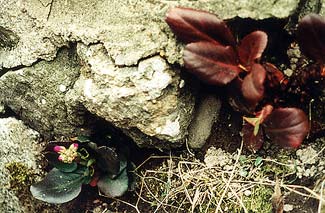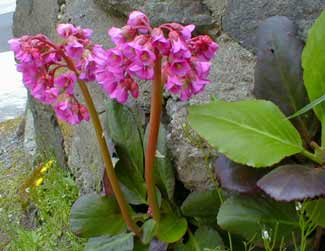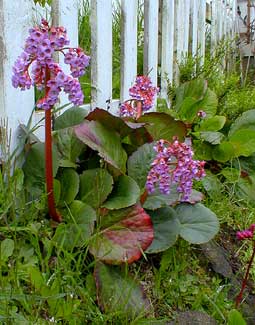 | |
When selecting bergenias it is easiest to start with a few adult plants rather than youngsters like these, unless you are patient. Small ones can take a long while to get so well rooted they begin spreading, whereas if you get them at least gallon-sized & root-bound, they begin spreading out the very next year. But I did get these two four-inch-pots to insert between stones in the vertical face of a small retainer wall of large rocks, as planting larger ones would've required me to disburb too much soil which rains & waterings would've washed out from between the rocks. Bergenias are so hardy there's really no question but that these will thrive in this rocky face. Both of these young plants are maroon-leaf varieties. On the right is B. cordifolia 'Winterglut' (or 'Winter Glow') which even in April is still red-leafed, but will have faded to green by the time it produces rich magenta blooms. To its corner left is 'Abendglocken' (or 'Evening Bells') which in early spring has lost all its autumn/winter hue, & has buds for the deep rosy-pink blossoms. Both of these bloom in April & May. | |
'Abendglocken'; aka,
'Evening Bells' Heartleaf
"Though all the Gods their garlands shower,
I too may bring one purple flower.
Alas! what blossom shall I bring,
That opens in my Northern spring?"
-Oliver Wendell Holmes
(1809-1894)
(1809-1894)
A good plant nearly impossible to kill is Bergenia, named for the 18th Century German botanist Karl August von Bergen. It is usually called Heartleaf, and sometimes called Elephant-ears, both names for the same reason of its giant round or heart-shaped leaves. My grandmother called Bergenias the Elephant Plant, because if an elephant stomped on it, it wouldn't die.
Bergenias have been in American & British gardens for two centuries at least, so I'm surprised it is not way better known with half a dozen pet-names like Leather Cabbages, Picnic Plates, & what-not. One does occasionally hear the unfriendly name Pigsqueak (because the slick leathery leaves will squeak if you rub them to get that "squeaky-clean" sound), though Heartleaf is certainly more melodious. It is to some extent an under-appreciated plant, just taken for granted without its praises often sung.
Bergenias spread by fibrous above-ground sideways stalks. As one of the first things I ever planted as a child, I loved it extravagantly because it gave such rewarding results without my having to know much about gardening. Now as I tumble headlong toward old age, the easy plants of my first gardens still have a sentimental value to me.
Bergenias like best a bit more than half sun, but not totally unprotected. It can become extremely green & lush in a partial-shade garden that is always damp, but if you stick it in too much sun & don't water it enough, it stays shorter & bronzier & may become a bit rusty looking or scruffy around the edges, but is apt still to spread & thrive.
The bronziest red-leaf varieties prefer a little more sun if you want to heighten the red effect, but Bergenias generally do suffer somewhat if they get no shade at all. Full shade won't wreck them, but they may develop longer necks trying to reach the sun, & the leaves will become floppier & a lighter green.
 Those with the greatest tendency to maroon winter color are varieties of the Siberian bergenia, B. cordifiolia, or hybrids dominated by its trait, or B. purpurascens, the Purple Pigsqueak. These have purple fall & winter leaves, & pink to red flowers in spring. Ruddy winter colors occasionally last until April but only occasionally are the March through May blooms occurring together with the winter-maroon of the leaves.
Those with the greatest tendency to maroon winter color are varieties of the Siberian bergenia, B. cordifiolia, or hybrids dominated by its trait, or B. purpurascens, the Purple Pigsqueak. These have purple fall & winter leaves, & pink to red flowers in spring. Ruddy winter colors occasionally last until April but only occasionally are the March through May blooms occurring together with the winter-maroon of the leaves.A pure B. crassifolia by comparison is more apt to remain green year round, & is also the one that blooms as early as December & certainly by February or early March. There are few clear-cut distinctions between the two main species, however, due to hybridizations, & because B. crassifolia will be ruddy in places with much colder winters, whereas B. cordifiolia may stay more wholy green in a shady area of a zone with warm winters, their appearances considerably overlap so that any alleged distinction cannot be relied upon for identification.
We get good red winter colors on our B. cordifolia 'Winterglut' & B. cordifolia 'Abendglocken.' The first photo at the top of this page shows both of these when they were first stuck into the hillside as tiny starts. In that early-April 2002 photo, the 'Abendglocken' on the left has already turned from red back to green & is starting to bloom, showing a glint of color in its buds. But 'Winterglut' on the right still shows a chocolaty-colored leaf, which began to green shortly after photographed.
The second photo is that same tiny specimen of 'Abendglocken' exactly one year later in April 2003, & it has grown quite a bit. In English called 'Evening Bells' its flowers occur on tall spikes & are a striking shade of dark lilac-pink. A third photo at the bottom is an unknown or unnamed B. cordifolia
 There are other species not so often seen here in the Northwest but available if one looks hard enough. Foremost of the scarcer ones is B. emeiensis. It is strikingly different from the others, a cliff-dwelling Bergenia that was only described as a new species in 1988. It has five-petalled white blooms rather more daisy-like than the usual hanging-bells. It is not nearly so cold-hardy & has not made many inroads to gardens in the Northwest, but is sometimes offered as a house plant, & as a garden variety in places with summers too hot for most Bergenias.
There are other species not so often seen here in the Northwest but available if one looks hard enough. Foremost of the scarcer ones is B. emeiensis. It is strikingly different from the others, a cliff-dwelling Bergenia that was only described as a new species in 1988. It has five-petalled white blooms rather more daisy-like than the usual hanging-bells. It is not nearly so cold-hardy & has not made many inroads to gardens in the Northwest, but is sometimes offered as a house plant, & as a garden variety in places with summers too hot for most Bergenias.Another warmer-weather species is B. ciliata with big fuzzy leaves & deciduous habit, again not offered much in the Northwest but available in the south, sold in white, pink, or purple varieties. B. pacumbis is one I've never seen, but it appears in some catalogs as a partial-shade rockery plant. B. scopulosa has two varieties on the market, with white blooms, or with pink blooms. B. stracheyi has small leaves & blooms in summer & fall; it has both white & pink varieties. All of these are of Asian origin.
The three mainly seen species (crassifolia, cordifolia, with purpurescens a distant third) together with their cultivars & hybrids are self-seeding, but because young plants don't easily compete under excessively-shading already established & thickly rooted adults, it is best to harvest the seeds & either sew them under leafmold in autumn where they'll winter quietly & sprout the following spring, or start them in pots (after they've been "wintered" in the refrigerator a few days so they will germinate) & put the seedlings in the ground come spring. The parent plants will be spreading without need of seedlings, & may occasionally have to be thinned down with some sections clipped out at the fibrous runners to be moved elsewhere or given away as gifts to fellow gardeners.
Continue to:
Bergenia crassifolia